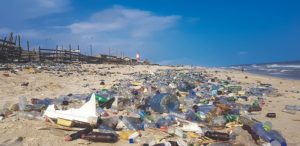California tackles climate change by restricting gas-powered vehicle sales
California aims to eliminate the sale of new gas-powered cars by 2035, a policy that many viewed to be a step in the right direction against greenhouse gas emissions and climate change.
October 3, 2022
On Aug. 25, 2022, California passed a policy that would prohibit the sale of new gas-powered cars and light trucks within the state by the year 2035. Although this proposal, Advanced Clean Cars II, does not directly ban the use of gasoline-powered vehicles, it aims to greatly reduce their prevalence by 2035 by both tightening regulations for these cars and by increasing the production and development of zero-emission vehicles. To this end, the state has set goals for the manufacture and sale of zero-emission vehicles: by 2026, they will account for 35% of new vehicle sales, growing to 68% by 2030 and 100% by 2035.
The passage of Advanced Clean Cars II takes place against the backdrop of severe climate change in the state of California. For instance, global warming has exacerbated the effects of the recent heat wave in California, in which several cities in the Bay Area experienced record-breaking temperatures upwards of 110 degrees. As California’s Fourth Climate Change Assessment notes, California ranks among the most “climate-challenged” states in the U.S., intensifying these extreme climate events.
With the worsening climate situation in California, many viewed the new policy as a step in the right direction for limiting greenhouse gas emissions. Data collected by the California Energy Commission shows that transportation alone makes up a significant portion of air pollution in California, including 50% of California’s greenhouse gas emissions and 90% of toxic diesel particulate matter pollution.
“One of our main sources of carbon dioxide is from transportation in general, and each individual action can make a big impact,” DVHS AP Environmental Science teacher Heida Shaw explained. “If we get rid of the sale of new combustion cars, it will drive innovation for electric cars, and that will be more useful for us overall. Because the more choices we have for electric cars, [we can] make them more efficient and better for the environment.”
Not only will the switch to zero-emission vehicles benefit the environment, but it will also affect air quality and human health. Poor air quality, resulting from emissions of greenhouse gases and pollution from diesel particulate matter, can lead to adverse health outcomes, including cardiovascular diseases, respiratory illnesses and death. According to data from the World Health Organization, outdoor air pollution accounts for millions of premature deaths every year.
Despite these benefits, the transition to zero-emission vehicles remains uncertain. For one, the cost of electric vehicles represents a major hurdle to implementing the ban. Due to rising costs of electric vehicle components, they cost $54,000 on average, whereas conventional vehicles cost only $44,400 on average, Business Insider found.
“In lower-income areas of California, especially the more rural areas, people don’t have as much money there. And car usage is pretty important in those regions as well, because they have to travel a lot just to get out and get supplies for their homes. It’s definitely going to affect them heavily,” DVHS senior Neel Mishra explained.
To address this issue, California plans to invest billions of dollars into making zero-emission vehicles more accessible to California residents. These initiatives, including Clean Cars 4 All and The Clean Vehicle Rebate Project, are planned to help ease the transition to zero-emission vehicles. As a result of this funding, the California Air Resources Board expects that by 2030, owning zero-emission vehicles will cost around the same as conventional vehicles; by 2035, owning zero-emission vehicles is expected to be thousands of dollars cheaper than conventional vehicles.
“As a consumer, we need better options like lower cost options for electric cars. As a person who owns an electric car, I definitely found it difficult to find cars at a reasonable price point,” DVHS Health teacher Dearborn Ramos commented. “But hopefully by 2035, I’m pretty confident that the automotive industry will have more options for us.”
Overall, despite potential hurdles with transitioning from gasoline to electric vehicles, the measure was viewed with optimism.
“I can understand the trepidation for people who are worried about having to switch to electric because of costs, because it’s unsure how we’re going to make that transition,” Shaw said. “But I don’t think that it’ll be too different from going from gas to having electric power stations. We don’t have that technology available to us yet, but it could happen. And then the lack of gas will only drive us towards inventing new things. I think it’s a great way to move forward.”
On a national scale, several states, including Washington, Massachusetts and New York, are expected to follow California’s lead in prohibiting the sale of gas-powered vehicles.
“Other states might follow suit, especially states with strong climate views, such as New York and Maryland. And states similar in their political views to California might definitely follow through as soon as we do it,” Mishra added. “Overall, if we start doing it as a state, that can lead other states to start doing it as well, and possibly even other countries.”
In light of the Paris Agreement, an international treaty aiming to restrict global warming to less than two degrees Celsius, California’s policy could provide the framework to help mitigate global greenhouse gas emissions.
“I think it’s an important step to ensure a more renewable future. If we don’t get carbon neutral, global warming is going to go off the rails and we’ll pass a tipping point which we can’t get beyond, so having a specific date in mind in which we’re going to have to make that transition is a good thing,” Shaw said.







